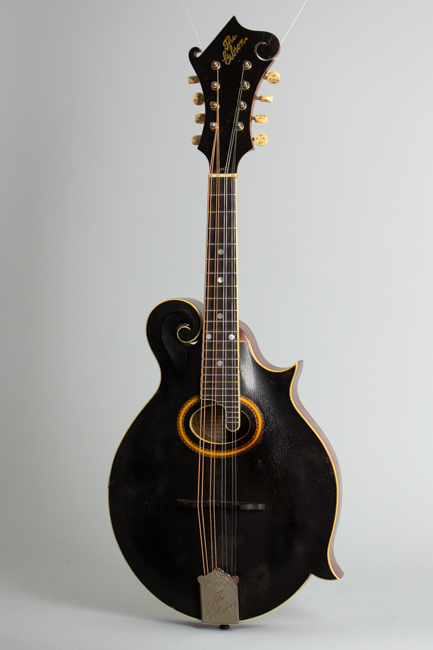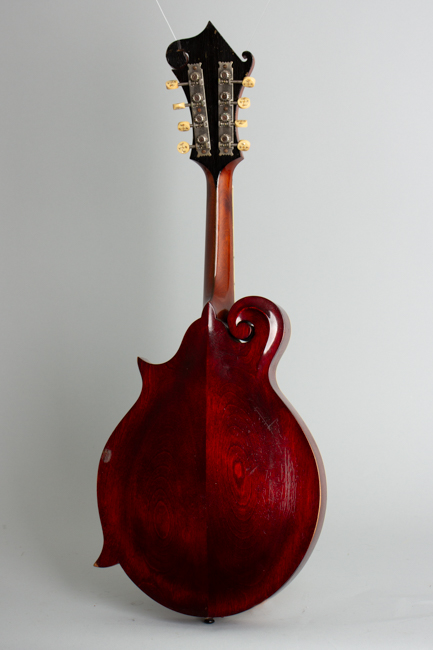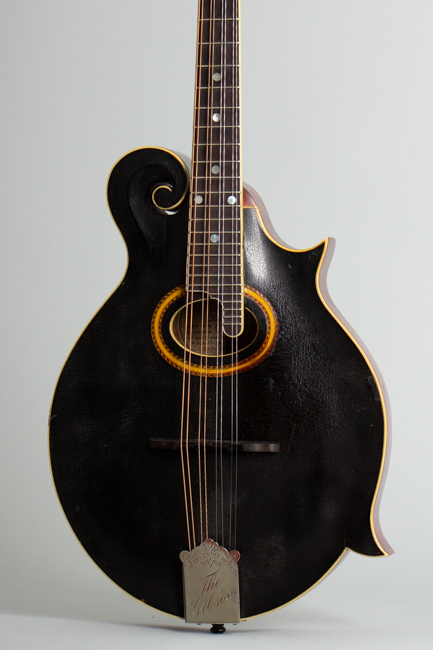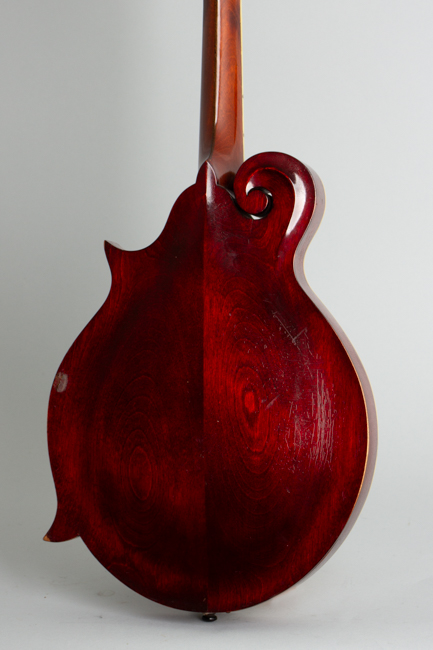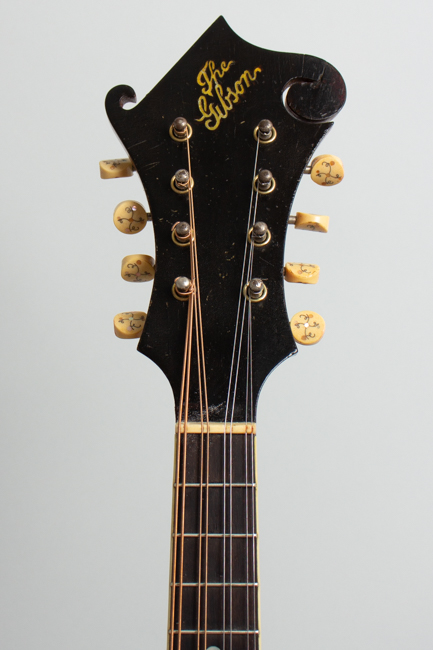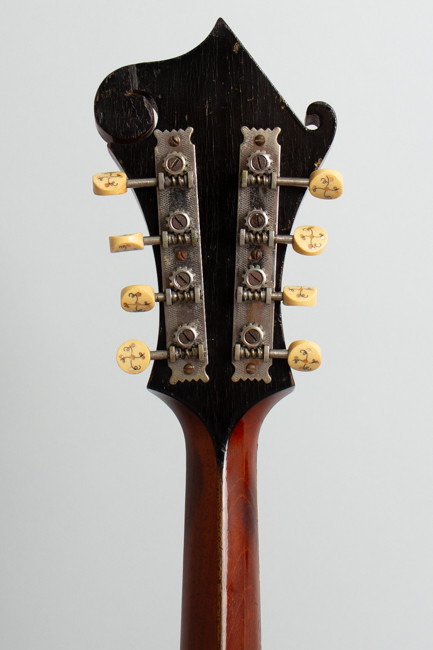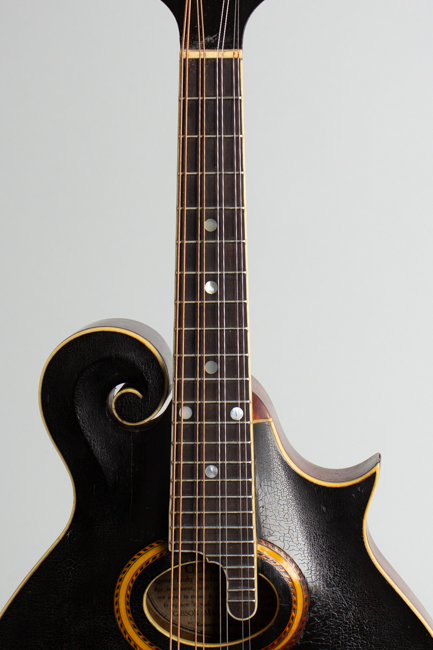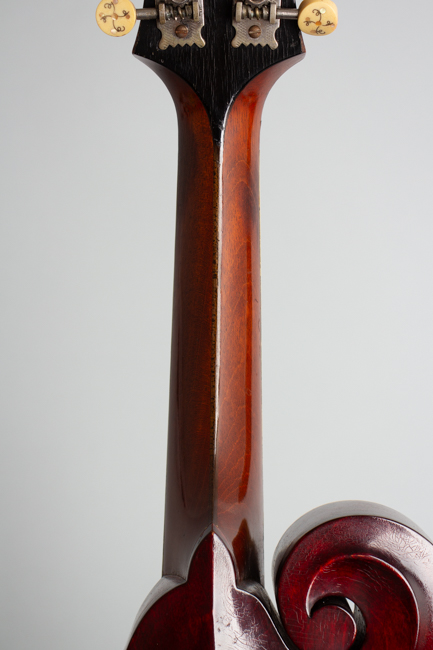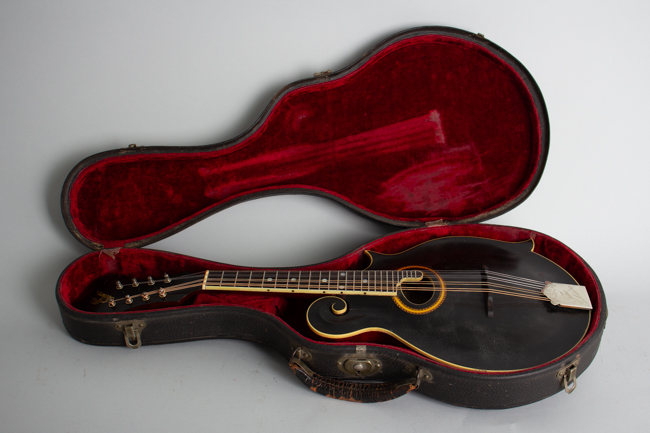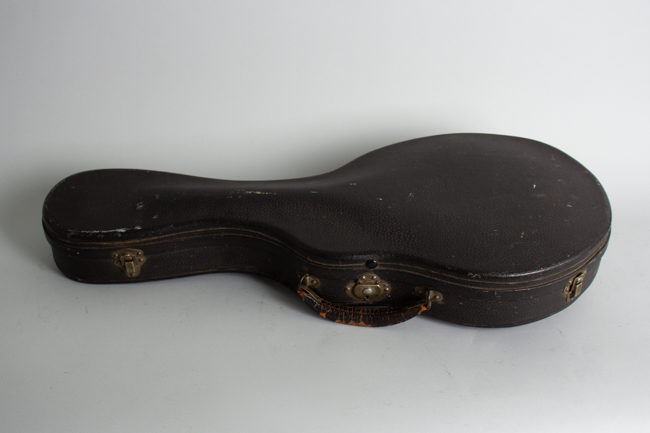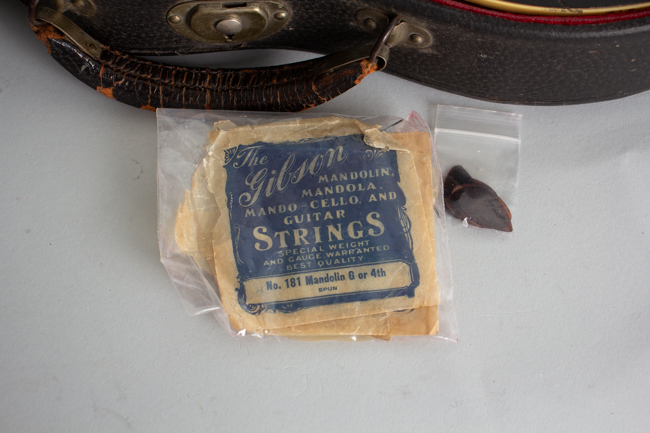Gibson F-2 Carved Top Mandolin (1914)
Gibson F-2 Model Carved Top Mandolin (1914), made in Kalamazoo, Michigan, serial # 22444, black top, dark stained back and sides finish, birch back and sides, spruce top; mahogany neck with ebony fingerboard, original black hard shell case.
When this beautiful instrument was made around the end of 1913 the F-2 "Artist Model" was the next to the top of Gibson's mandolin line, and at $75.00 "net" price very expensive by period standards. It is built to the same structural design as the top-line F-4, but lacking some that model's fancier decorative elements. The single major difference is the F-4 was the only early Gibson actually built with maple back and sides; like the rest of the line the F-2 is built of birch despite what the catalogs said! This sometimes gives them a slightly softer tone, sweeter and not as strident; sometimes it seems to make no difference at all!
The Factory Order Number ink-stamped on the neck block is 2491 dating to late 1913; the serial number indicates the instrument was shipped early the next year. The fittings are standard for this period; the raised celluloid pickguard and clamp are long gone but the beautiful Handel tuners with inlaid celluloid buttons are intact as is the engraved tailpiece cover. The solid ebony bridge appears to have been rebuilt with a one-piece carved ebony cap in place of the original individual compensated saddle pieces. The scrolled headstock carries the familiar "The Gibson" slanted pearl logo. In 1913 many of these design elements wear recent developments, and the Gibsons from this period represent the first full flowering of these incomparable and at the time absolutely unique mandolins.
This F-2 shows general wear but still looks beautiful with its lovely gleaming ebony top ready to celebrate its next 100+ years. The nicely preserved original hardshell case also includes some original period 100+ year old glassine Gibson string packets that are rare in themselves, and some period celluloid picks.
Overall length is 26 1/4 in. (66.7 cm.), 10 1/16 in. (25.6 cm.) width, and 1 11/16 in. (4.3 cm.) in depth, measured at side of rim. Scale length is 14 in. (356 mm.). Width of nut is 1 3/16 in. (30 mm.).
This striking ebony-topped mandolin has survived 110 years showing some wear and minor repair but still remaining a lovely instrument to in every way. The finish is completely original; the black varnish on the top is still shining with quite a bit of typical fine micro-checking and some light wear. The back and sides are checked as well but not as intensely. There are scattered small dings and dents with wear along the back edge but mostly the body finish is relatively clean. The neck finish remains original with some wear down to the wood in the first position. The headstock face shows fine checking and a typical ancient scroll repair, solidly if less elegantly done than some.
There is one old grain crack to the top below the scroll running to an inch or so forward of the soundhole. A couple of spots along the back/side seam have been resealed, again as typical. The original hardware includes the tuners, tailpiece, and base of the bridge; as noted the bridge top has been re-worked for suppler action. The pickguard is long gone, the original elegant tailpiece cover has some old corrosion along the front edge.
The original frets of this era were very small wire; this mandolin has been refretted with slightly larger wire and these have been recently re-crowned lightly so are nicely playable. The bone not is original and has been lightly shimmed. Overall this is a very sweet and enjoyable mandolin with a sparkling sound, not as loud as some but superbly playable with a comfortable action. It still rests in an extremely well preserved original shaped HSC, with some period strings and picks still resting in the case after 100 or so years. Overall Very Good + Condition.
When this beautiful instrument was made around the end of 1913 the F-2 "Artist Model" was the next to the top of Gibson's mandolin line, and at $75.00 "net" price very expensive by period standards. It is built to the same structural design as the top-line F-4, but lacking some that model's fancier decorative elements. The single major difference is the F-4 was the only early Gibson actually built with maple back and sides; like the rest of the line the F-2 is built of birch despite what the catalogs said! This sometimes gives them a slightly softer tone, sweeter and not as strident; sometimes it seems to make no difference at all!
The Factory Order Number ink-stamped on the neck block is 2491 dating to late 1913; the serial number indicates the instrument was shipped early the next year. The fittings are standard for this period; the raised celluloid pickguard and clamp are long gone but the beautiful Handel tuners with inlaid celluloid buttons are intact as is the engraved tailpiece cover. The solid ebony bridge appears to have been rebuilt with a one-piece carved ebony cap in place of the original individual compensated saddle pieces. The scrolled headstock carries the familiar "The Gibson" slanted pearl logo. In 1913 many of these design elements wear recent developments, and the Gibsons from this period represent the first full flowering of these incomparable and at the time absolutely unique mandolins.
This F-2 shows general wear but still looks beautiful with its lovely gleaming ebony top ready to celebrate its next 100+ years. The nicely preserved original hardshell case also includes some original period 100+ year old glassine Gibson string packets that are rare in themselves, and some period celluloid picks.
Overall length is 26 1/4 in. (66.7 cm.), 10 1/16 in. (25.6 cm.) width, and 1 11/16 in. (4.3 cm.) in depth, measured at side of rim. Scale length is 14 in. (356 mm.). Width of nut is 1 3/16 in. (30 mm.).
This striking ebony-topped mandolin has survived 110 years showing some wear and minor repair but still remaining a lovely instrument to in every way. The finish is completely original; the black varnish on the top is still shining with quite a bit of typical fine micro-checking and some light wear. The back and sides are checked as well but not as intensely. There are scattered small dings and dents with wear along the back edge but mostly the body finish is relatively clean. The neck finish remains original with some wear down to the wood in the first position. The headstock face shows fine checking and a typical ancient scroll repair, solidly if less elegantly done than some.
There is one old grain crack to the top below the scroll running to an inch or so forward of the soundhole. A couple of spots along the back/side seam have been resealed, again as typical. The original hardware includes the tuners, tailpiece, and base of the bridge; as noted the bridge top has been re-worked for suppler action. The pickguard is long gone, the original elegant tailpiece cover has some old corrosion along the front edge.
The original frets of this era were very small wire; this mandolin has been refretted with slightly larger wire and these have been recently re-crowned lightly so are nicely playable. The bone not is original and has been lightly shimmed. Overall this is a very sweet and enjoyable mandolin with a sparkling sound, not as loud as some but superbly playable with a comfortable action. It still rests in an extremely well preserved original shaped HSC, with some period strings and picks still resting in the case after 100 or so years. Overall Very Good + Condition.
